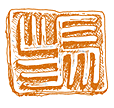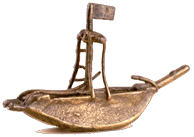| Essay, part 1 Introduction Essay, part 2 Trading Gold for Salt Essay, part 3 Mining the Gold Essay, part 4 Using Gold-Dust as Money Essay, part 5 Trading with Europeans |
Using Gold-Dust as Money
Until the nineteenth century, the Akan used grains of gold-dust, as well as objects such as cowrie shells, as their medium of exchange. The Akan didn't use price tags, the way we do today, to indicate how much an item cost. Instead, they determined the price by using a system of brass weights and scales. This system had come to the Akan by way of the Islamic North African camel caravans that did business at the trading centers of Djenne and Timbuktu. From there the system spread south to the Akan.
 Equipment
Equipment
The buyer and the seller each brought his own weight bags to carry out a transaction. Inside was a small scale, a spoon, and bronze weights of varying sizes. The buyer had a metal box containing a tiny amount of gold-dust wrapped up in a small piece of cloth and secured with a knot.
Negotiation
Because no prices were set, all prices were negotiated with a series of offers and counter-offers. To start off, the seller, hoping to get a high price, would pull a heavy brass weight out of his weight bag. The buyer, who hoped to pay less than what was being asked, pulled a lesser brass weight out of his bag. The two bargained back and forth, each producing additional or alternative brass weights, until they finally agreed which weight would determine the amount of gold-dust to be paid.
Weighing
At this point, the buyer opened the cloth in which his gold-dust was carefully wrapped. He measured a small amount of gold-dust onto the scale, adjusting it with a spoon until the weight balanced. Then the seller reweighed the gold-dust with his own weights and scales to make sure that the transaction was fair.
 Akan weights
Akan weights
Akan metalsmiths produced about four million weights over several centuries. These weights were small, compact, durable, and easy to carry around. They did not break or lose their weight value unless someone tampered with them.
A set of weights progressed from lightest to heaviest. Several weights could be placed on the scale at once. A common person owned just a few weights while a rich one might have owned close to sixty.
 Akan
weights are of two types. One is a geometric weight, the other depicts familiar
figures or objects such as antelopes, chickens, snakes, crocodiles, birds,
fish, insects, seeds, weapons, tools, and even people.
Akan
weights are of two types. One is a geometric weight, the other depicts familiar
figures or objects such as antelopes, chickens, snakes, crocodiles, birds,
fish, insects, seeds, weapons, tools, and even people.
Outsiders may find the Akan weights confusing, because their appearance has nothing to do with their assigned weight. We cannot tell how heavy a weight is simply by looking at it. A bird and a fish might have the same weight, but two birds that look exactly the same might have different weights.
Many Akan weights are associated with proverbs. The Akan like to use
proverbs in their everyday speech to communicate
ideas or feelings that might be considered impolite if stated more directly.
